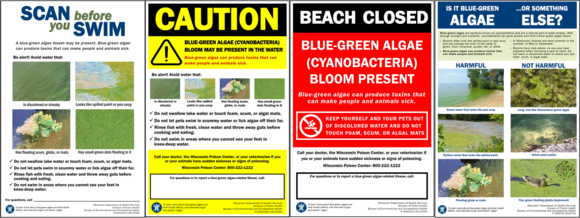 Program Updates
2019 In Review
Do you remember our 2019 resolutions from our January 2019 issue? We made resolutions to reach and work with specific target populations to improve knowledge of and build capacity for blue-green algae preparedness and response. Here’s how we did it:
Summer camp directors and staff
We worked with a recreational and educational camp specialist at the Department of Agriculture, Trade, and Consumer Protection (DATCP) to develop a fact sheet for summer camp directors and staff about blue-green algae and camper safety. In addition, the HAB Program worked with DATCP to revise a protocol for environmental health officials conducting camp inspections to include precautions for blue-green algae blooms affecting designated water recreation areas.
Researchers and citizen scientists within the Red Cedar Watershed
The HAB Program epidemiologist delivered a closing keynote presentation alongside the Department of Natural Resources (DNR) blue-green algae coordinator at the Red Cedar Watershed Conference, a regional event drawing local scientists and members of the general public who are interested in protecting the health of their local lakes.
Health departments serving communities near lakes Castle Rock and Petenwell
Our HAB Program epidemiologist and DNR blue-green algae coordinator met with health department and parks department officials to discuss local challenges and solutions surrounding blooms and beach management.
Visitors to the Apostle Islands National Lakeshore
We worked with National Park Service officials to bring beach signage and an informational wallet card to the Apostles to improve public knowledge and awareness of blue-green algae.
Health departments and tribal environmental agencies within the Great Lakes Basin
We teamed up with the Lake Superior National Estuarine Research Reserve to lead a day-long training for professionals in the Lake Superior South Shore area on regional blue-green algae preparedness and response.
 The HAB Program’s new signage offerings were featured in a Great Lakes Restoration Initiative news story—check it out!
What's in store for 2020?
In 2020, our focus will be to continue building capacity for HAB preparedness and response at local health and tribal agencies across Wisconsin. Look out for future announcements of regional in-person and webinar training opportunities!

A huge "thank you" to the 38 local health jurisdictions that responded to the 2019 survey! Your feedback is extremely important. Our goal is to use the information you provided to guide HAB Program activities so that we are most efficiently and effectively meeting health-related HAB needs at the local and tribal level. Here’s what we learned:
Knowledge of harmful algal blooms rose between 2018 and 2019
In 2018, 26% of survey respondents reported that they knew very little about HABs compared to only 11% in 2019. Those with a moderate amount of knowledge of HABs and those with a lot of knowledge grew by 4% and 11%, respectively, from 2018 to 2019.
Knowledge of and communication with the DPH HAB Program rose between 2018 and 2019
In 2018, 23% of survey respondents reported not knowing about the DPH HAB Program prior to taking the survey, compared to 8% in 2019. Those who knew of the program and those who both knew of the program and have communicated with it rose 6% and 9%, respectively, from 2018 to 2019.
HAB preparedness rose between 2018 and 2019
In 2018, over 50% of survey respondents reported that their department was not well prepared to answer questions from the public or the media about blue-green algae compared to 32% in 2019. Those who reported being somewhat prepared and well-prepared rose 13% and 8%, respectively, from 2018 to 2019.
The HAB Program Newsletter helped increase agency HAB preparedness in 2019
The DPH HAB Program initiated the HAB Program Newsletter in 2019 to serve as a resource for local health and tribal agencies in addressing harmful algal blooms and related illnesses within their jurisdictions. Approximately 4 of 5 survey respondents reported having read the newsletter, with over 50% reporting having read most issues or every monthly issue.
Eighty percent (80%) of respondents who had reported reading the newsletter agreed that the newsletter had some positive effect on their agency’s HAB preparedness, with a third reporting that the newsletter increased their agency’s preparedness a lot.
So, what did respondents like most about the newsletter? Here are some of their comments:
- “Helped me keep BGA in my mind ahead of time so I was more prepared for the season.”
- “It was nice to keep current and up to date.”
- “General information and pictures are always helpful.”
- “Excellent graphics to show the various types of HAB.”
- “All of the information was helpful and interesting.”
- “The newsletter was informative. If I had received questions about blue-green algae I would have consulted the newsletter as a resource.”
Without a doubt, the HAB Program is thrilled with the overwhelmingly positive response to the newsletter. We thank our readers and look forward to continuing to share interesting and useful information as the 2020 season closes in.
|
Workshop: Managing and Monitoring for HABs and E. coli in Recreational Waters
The EPA and Conservation Technology Information Center (CTIC) are sponsoring a national workshop on recreational water quality in Chicago during April 21–24, 2020. The goal for this workshop is to aid recreational water managers, researchers, stakeholders and public health officials at all levels to share information and ideas about implementing and supporting a successful recreational water program. This workshop will focus on two common contaminants: harmful algal blooms and fecal contamination. The workshop will provide information on tools, training, and an opportunity to discuss strategies for managing and monitoring HABS and fecal contamination in recreational waters. The workshop will provide opportunities for sharing across programs on management of these issues.
We would love to see representation from Wisconsin! If you are a public health, environmental health, or natural resource official, please consider attending and/or presenting your jurisdiction’s work! There is no registration fee. Abstracts are due January 20, 2020 and registration is now open. Visit CTIC’s website for more information.
Great Plains and Midwest Harmful Algal Blooms Conference
The EPA’s Office of Research and Development, Region 7 and the University of Kansas Edwards Campus are co-hosting the Great Plains and Midwest Harmful Algal Blooms Conference during February 4–5, 2020, to explore issues and solutions surrounding HABs in waterbodies within the Midwest and Great Plains. Discussions will focus on both identifying the issues and challenges associated with excess nutrients leading to the formation of HABs in the Great Plains and Midwest regions, as well as the best practices for nutrient reduction and source water protection to prevent HABs in agriculturally dominated waterbodies. The intended audience for the workshop is water quality professionals from state and tribal water quality programs in U.S. EPA Regions 5, 7 and 8, academic institutions, and other federal programs.
This event is free. For more information and to register, go to the Eventbrite site.
 |
|
Missed a past issue? Previous issues are available on our Resources for Health Professionals webpage.
Email us your burning questions! If others can benefit from hearing the answer to your question, we’ll feature it in a future issue.
Remember that we are always available for consultation on any HAB health-related issue by email or phone (608-266-1120).
|
|